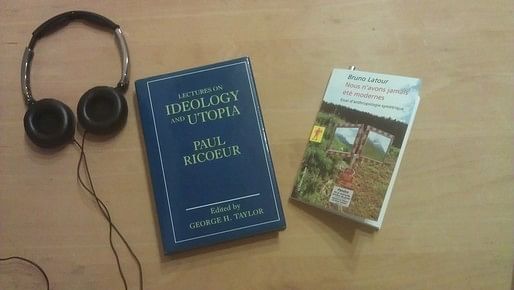
For the past few weeks I have been thinking mostly about modernity and ideology. We talk often in architecture about the relationship between theory and practice. Like the opposition of public/private or political/autonomous, the duality of theory and practice feels both important and stale - predictably provocative to the point of being terribly boring. Understanding ideology and modernity as related phenomena may be a way around this over-wrought divide.
Science figures largely in the references I am looking at. Before getting too far from architecture, let me mention Frederick Kiesler. In 1937 Kiesler introduced a laboratory research model to the Architecture school at Columbia University with the "Laboratory for Design Correlation" - apparently the first Lab in any architecture school. Despite having invented the format that would become arguably one of the leading models of architecture education of the next century, Kiesler was ostracized in the field, and his lab only lasted 5 years. Grey Room has a great article on this by Stephen Phillips in the winter 2010 issue.
In architecture we are accustomed to adopting the methods of science without necessarily claiming science, itself, as a goal. I am thinking not only of the model of the laboratory, but also the appropriation of biology, computer science, and even social science. Until recently I assumed this concern with the scientific had something to do with a rise of digital methodology and complexity. I have been more interested in Utopia and understanding architecture's co-dependent relationship with Utopia. Increasingly, though, I am seeing the Utopian project as less of an alternative to the scientific and more a side-effect of it.

According to Ricoeur, ideology has an intimate relationship to science. In "Lectures on Ideology and Utopia" Ricoeur considers ideology and Utopia as two modes of distinguishing from the real. He makes a distinction between early Marx and late Marx. In Marx's early writing on Hegel, [T]he main opposition in Marx at this point is not between science and ideology, as it becomes later, but between reality and ideology. The conceptual alternative to ideology for the young Marx is not science but reality, reality as praxis. People do things, and then they imagine what they are doing in a kind of cloudy realm. The relationship of ideas to things, thingness, and practical reality under-girds the opposition of science to ideology. We make our ideas scientific in order to not be ideological, all the while avoiding the gap between our ideas and reality.
Bruno Latour addresses this gap head on in "Nous n'avons jamais été modernes" - his 1991 book on modernity and its possible anthropology. A short version of this - I'm only about a quarter through - might be that modernity constitutes itself by making this gap between things and ideas (as between science and politics, non-humans and humans) in order to give things more power.
If all of this feels too outside of architecture, take a look at the interior of this Corbusier 2-family apartment building at Weißenhofsiedlung. I took the Stuttgart subway there on Thursday.

This Corbusier-Jeanneret project is sited in a Mies van der Rohe masterplan that consists of 21 houses and 63 apartments. The whole project was built somehow in 21 weeks and evolved out of an exhibition called "Die Wohnung." When modernity allows itself to be ideological, it can actually be incredibly, unexpectedly, productive.
- Mitch
Architecture Fellow at Akademie Schloss Solitude, Stuttgart, Germany
Posts are sporadic. Topics span architecture, urban design, planning, and tangents from these. I sometimes include excerpts of academic articles.
1 Comment
it's a tough one, but for germany's path to modernity, this book is critical. turn of the 20thC germany through ww2 was a fascinating time in german design - separate but obviously wed to the political turmoil. behrens and tessenow were such pivotal figures in so much of what was going on in the early period, and they aren't discussed nearly enough (imo, naturally).
http://www.amazon.com/Figures-Architecture-Thought-Culture-1880-1920/dp/0847806545/ref=la_B001JOIN50_1_4?ie=UTF8&qid=1354366392&sr=1-4
Block this user
Are you sure you want to block this user and hide all related comments throughout the site?
Archinect
This is your first comment on Archinect. Your comment will be visible once approved.